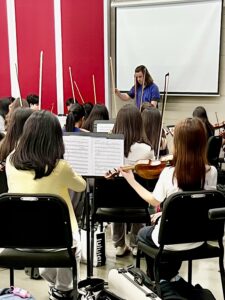Located in Santa Ana, California and operating for 20 years as a charter school, OCSA says that it “offers a dynamic school culture that enables students to flourish as artists and scholars in a uniquely challenging and nurturing environment, celebrating creativity, individual growth, and opportunity.”
The school, which enrolls around 2,300 students in grades 7-12, “embraces and encourages academic and artistic excellence, preparing students to reach their highest potential and thrive in 21st Century.”
 In addition to an excellent faculty, the school also brings in guest artists and industry leaders to “share their expertise their expertise and creativity through OCSA’s Master Artist Series, exposing students to one-of-a-kind master classes, lectures, presentations, and hands-on training.” Renowned artists who have guest-taught at the school have included director Francis Ford Coppola, cellist Yo-Yo Ma, trumpeter Wynton Marsalis, actress Zendaya, artist Paul Frank, and mezzo-soprano Susan Graham.
In addition to an excellent faculty, the school also brings in guest artists and industry leaders to “share their expertise their expertise and creativity through OCSA’s Master Artist Series, exposing students to one-of-a-kind master classes, lectures, presentations, and hands-on training.” Renowned artists who have guest-taught at the school have included director Francis Ford Coppola, cellist Yo-Yo Ma, trumpeter Wynton Marsalis, actress Zendaya, artist Paul Frank, and mezzo-soprano Susan Graham.
The school offers students both a rigorous academic program and variety of arts programs.
On an average school day, students will attend five hours of college-preparatory academic classes, which have been recognized by state and federal education agencies, U.S. News & World Report, and others as being among the most demanding and intensive in Southern California.
Students also take two hours of arts courses, which span five schools of study: applied arts, dance, fine and media arts, music, and theatre. Every year, students at the school present more than 200 performances, presentations, and exhibitions at local, national, and international venues, from Segerstrom Center to Carnegie Hall to the Sydney Opera House.
I recently visited OCSA and witnessed for myself the amazing talents of the school’s students.
For example, I walked into a practice room where the school’s orchestra just happened to be playing American classical composer Aaron Copland’s famous setting of the Shaker hymn “Simple Gifts.”
Gifts.”
Listening to the young people play that work, which happens to be one of my favorites in the classical catalogue, I felt a great inner elation that brought tears to my eyes. As the notes from Copland’s masterpiece filled the hall, I realized that these were not just high school musicians, but accomplished artists capable of uplifting their audience and drawing out a great emotional response even when they were just practicing.
I also observed a painting class and was able to talk to several students, including a senior named Jenny. Sporting a Los Angeles Kings hockey shirt, Jenny had just completed an amazing self-portrait that featured her surrounded by depictions of photographs of people who were important in her life. I collect art and Jenny’s painting would be more than worthy of hanging in many of the galleries I have visited.
In a pottery class where students were busy creating fanciful ceramic cupcakes. I was drawn to a creation by a freshman named Angelyn who eschewed cupcakes in favor of a Buche De Noel, a traditional European chocolate Christmas cake, which is also one of my favorite holiday desserts. While she had yet to color it, Angelyn’s Buche was so realistic that it made my mouth water just looking at it.
 Given what I saw when I visited the school, it is no surprise that the U.S. Department of Education and the National Endowment for the Arts have recognized OCSA as a model arts education program.
Given what I saw when I visited the school, it is no surprise that the U.S. Department of Education and the National Endowment for the Arts have recognized OCSA as a model arts education program.
Further, an astounding 98 percent of the school’s seniors were accepted into institutions of higher education in 2024. The senior class had an average GPA of 3.9 out of 4.0, and given the recognized rigor of the coursework, student GPAs are due to merit, not grade inflation.
In view of OCSA’s incredible success, one might ask: Who would want to harm this school and its students?
Cue the dark organ music for the heavy in this story—the Santa Ana Unified School District.
For a long time, the Santa Ana district has been one the lowest performing districts in California.
While 84 percent of OCSA students met or exceeded grade-level standards on California’s English standardized exam, only 31 percent of SAUSD students met or exceeded those standards.
On the state math test, three quarters of OCSA students met or exceeded grade-level standards, while just one out of five SAUSD students met those benchmarks.
But the controversy between OCSA and SAUSD does not involve student-achievement disparity, but money.
By state law, charter schools are required to be a part of a local special education plan area. OCSA chose to be part of SAUSD’s area since the district had authorized OCSA’s status as a charter school and thus the school had to contribute an equitable share of its funding to the district to cover any unfunded special education costs that encroached on the district’s general fund.
OCSA’s allotted state special education funding went directly to SAUSD and the district would reimburse OCSA for the school’s special education expenses and then the district would keep any excess as a windfall.
Thus, from 2002 to 2020, OCSA was reimbursed for $8.8 million in special education services it provided to its students, while SAUSD pocketed more than $11 million in additional revenue.
Also, school districts can bill charter schools for additional so-called “general fund support.” However, since OCSA had allowed SAUSD to retain millions in excess funds, the school had satisfied its equitable-share requirements without the need for additional general fund support to the district—or so it thought.
In 2019, with no notice, the district billed OCSA for $19.5 million in additional general fund support covering a period of nearly two decades and gave the school just 30 days to pay it. The trouble with this demand was that it clearly violated the provisions of the contract signed between the district and the school.
Under the terms of the agreement, the district had agreed to provide OCSA with 15 months of notice if it was assessing general fund support; had agreed to calculate the school’s share of general fund support at the end of each fiscal year; had agreed to provide the school with evidentiary documentation, plus an opportunity to respond; and had agreed to estimate the school’s share of the general fund by June 30th of the preceding year.
The district did none of those things yet still demanded almost instant payment.
Further, the leadership of the district tried to force the school to pay up by threatening to withhold other state funds the school needed to operate.
Not surprisingly, the dispute landed in the courts. Two judges ruled in favor of OCSA, with one incredulous judge writing, “Although [SAUSD] claims a right to collect the sums at issue it had evidently failed to demand any such payments for the prior 17 years” and noted that the district had failed to meet its own requirements for invoicing the school.
But, after court shopping, the district found an about-to-retire judge who ruled for the district and basically said that the district did not have to adhere to the provisions of the agreement it had signed. The school has appealed to a state appellate court.
OCSA President and CEO Teren Schaffer, whom I met when I visited the school, has said: “We’re completely hamstrung from a cash position because we’ve had to take all of our available cash reserves, plus we have had to go borrow additional money from a bank, to put it into appellate bonds while we’re fighting this litigation.”
At stake is the literal survival of one of the best schools in America. If the courts rule that OCSA must pay the somewhat lowered $16.5 million in dispute, the result will be that the school would be forced to file for bankruptcy.
Why is SAUSD so determined to drive OCSA into insolvency and collect this money? The answer is sad and simple: the district’s own fiscal mismanagement has resulted in a $180 million budget deficit, so district leaders are looking for any pots of money to bail out the flailing district.
Schaffer says, “This blatant cash grab is a lose-lose for both the community and OCSA students and families.”
“This sudden financial demand was not only unjustified,” he emphasized, “it amounts to financial extortion.” And while he says that the “facts are in our favor,” these financial demands and threats against the school “have created a detrimental climate for our school and the community.”
For its part, the district claims that if cannot settle for anything less than the amount in dispute because it would then be making a supposed gift of public funds to OCSA. Yet, a new memorandum from Orange County Department of Education’s top lawyer debunks that claim.
According to OCDE General Counsel Greg Rolen, under California law public entities like school districts can settle cases for less than the disputed amount if the settlement “serves a public purpose and is supported by adequate consideration.” Districts “can determine that a settlement serves a public purpose” and courts “have also found resolution of a good faith dispute is adequate consideration.”
Thus, if OCSA and SAUSD mutually agree to a settlement that satisfies both these prongs, then it “is a permissible public expenditure.” OCSA has made a $4 million settlement offer.
“The facts are in our favor,” says Schaffer, and he and the school “remain hopeful for a resolution that places students first and reinforces our commitment to artistic and academic excellence.”
OCSA alumni have said that the school changed their lives.
Actor Justice Smith, who has appeared in movies such as Jurassic World: Fallen Kingdom and Dungeons and Dragons: Honor Among Thieves, has stated, “I don’t think I would be where I am if it wasn’t for this school.” He said that OCSA “helped give me the confidence I need to go out and work.”
Xochitl Luna, who went from OCSA to MIT, said that the school “is so much more than an arts school,” but rather it is “a place for well-rounded, creative scholars to find a home.”
OCSA is therefore more than just a school worth saving. It is a school that is worth emulating. Hopefully, the courts will understand what is at stake and prevent a greedy school district from stealing this educational gem away from students and from California.

